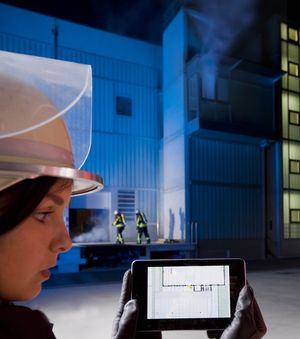KANBrief 4/16

Smart clothing is in vogue. There is no shortage of ideas, but implementation and standardization are still in their infancy. This presents an opportunity for the expectations, experiences and suggestions of the intended users to be surveyed and to be given consideration from the outset during development of standards. KAN has conducted a workshop with firefighters that is intended to do just that – and which can also serve as a blueprint for other topics.
Jackets with hands-free communication devices, sensors with position reporting, air-conditioned clothing, health monitoring systems with automatic emergency call function – the list of ideas and scope for application is endless. Numerous manufacturers are currently developing items of protective equipment that combine traditional PPE (personal protective equipment) with smart sensor and data transfer modules and that hold the promise of greater safety for Germany's firefighters, who number over a million.
The first products have already been presented at trade fairs and are available for purchase. Harmonized technical specifications are now needed in order to guarantee that these products function reliably and do in fact raise the existing level of protection. A European Commission standardization mandate is currently being discussed that is intended to lead to standards for smart PPE ( see also KANBrief 1/16) for protection against heat and flames.
Involvement of all relevant users
Users are a stakeholder group that is generally represented exceptionally sparsely on standards committees, despite being able to contribute particularly valuable opinions and experience. KAN aims to help close this gap, and is exploiting its close contacts to employers' and employees' bodies and to the prevention departments of the accident insurance institutions for this purpose.
The workshop held in June 2016 was attended by product users drawn from full-time, company and voluntary fire services. The accident insurance institutions at which the firefighters are insured were also represented, as were the research departments of the German Federal Institute for Occupational Safety and Health (BAuA) and the Institute for Occupational Safety and Health of the DGUV (IFA).
Less is more – and no gimmicks please
Some fire services have heard of smart protective equipment or have encountered it at trade fairs or on training courses. Few of them have already had personal experience of such products, however. The general conclusion of the workshop was that the additional functions must always enhance safety. Gimmicks and the excessive collection of data are two things that must be avoided. The workshop yielded a wealth of concrete suggestions:
Data
Less is more" is the motto when it comes to presentation of the data to the wearer. He or she can otherwise be rapidly overloaded with information that either distracts from the principal task, or is simply ignored.
Wearers want to trigger the display of certain data themselves.
An important concern is that the systems should not collect and store the wearer's biometric data continuously or by default.
Functionality
Acceptance
Incorporating the results into standards
The breadth of the results shows that the users have a positive view of this method of gathering experience. Standards developers are called upon to involve experts from the field closely in the formulation of relevant requirements.
Dr. Michael Thierbach
thierbach@kan.de